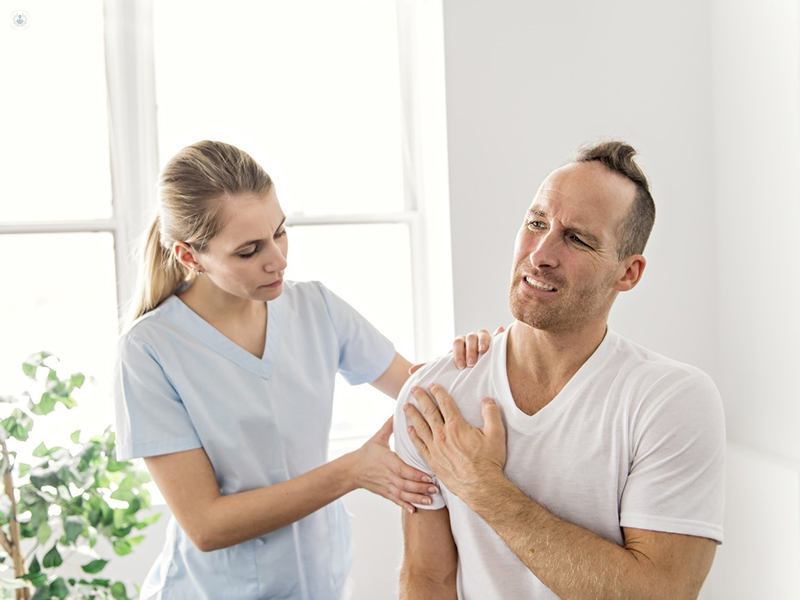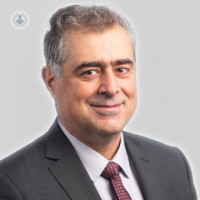Repairing the rotator cuff
Written by:The rotator cuff is a cowl-shaped accumulation of muscles and tendons that wrap around the humeral head of the shoulder joint and keep it centred in the socket. The shoulder joint is generally quite unstable. The rotator cuff maintains shoulder stability in the socket, allowing lager muscles outside it (deltoid, pecs etc.) to produce the overall movement.
Rotator cuff tears can occur naturally with age, with a 40 per cent chance that a tear will occur when you’re 80 years of age or older (often asymptomatic). They also occur as a result of an injury. We asked shoulder and elbow surgeon, Mr Dimitrios Karadaglis, about rotator cuff tears and their recovery.

What can cause a rotator cuff to tear?
A rotator cuff tear is a strain or tear of the internal tendons that stabilise the shoulder joint. Injury occurs mostly to the rotator cuff tendons (the tissue connecting muscles to bones) rather than the fleshy muscle parts.
Tearing of the rotator cuff occurs naturally with age. The older a person is, the more likely they are to have a tear, even an asymptomatic tear that doesn’t cause any obvious problems. Common symptoms would be:
- a pain, typically felt at the lapel region, especially on moving the shoulder against resistance.
However, rigorous daily activity, as well as injury, can also promote tearing. Exercise done in extreme positions (extremes of external or internal rotation) can cause or worsen tears. For example, how a person holds weights can affect the frictional pressure on an already compromised tendon: for example, weights lifted behind the head (extreme external rotation) - this can cause extra strain on the tendon. Exercise should always be done within a person’s comfort range to prevent shoulder injury.
How long does it take to recover from a rotator cuff tear?
Recovery from a rotator cuff tear depends on the nature of the tear. If the tear is minor, partial and not retracted, recovery can be expected within three months. Generally, the younger the person, the faster the recovery.
Low to medium-level solutions
Sometimes, tears can heal by themselves by avoiding strenuous actions and using anti-inflammatories. Physical therapy, stretches and activity modification also benefits patients. Sometimes cortisone or PRP injections might need to be given.
Surgical solutions
Older patients with tears that don’t settle, and anyone with persistent symptoms that don’t improve sufficiently with a reasonable trial of non-operative treatment, will require surgery. Where there is a clear link to a traumatic event, surgery is more urgent. Surgery takes between six and nine months to recover from in terms of return to forceful activity.
Operative treatment can be either open or arthroscopic. Arthroscopic surgery is generally performed, however, if a patient has a retracted tear or multiple tendons torn, open surgery might be the best option.
Should I do rotator cuff repair exercises?
Exercises are important to keep the shoulder mobile, however, exercises need to be done within a comfortable range. Any extremes of rotation should be avoided. Typical exercises include pendulum exercises and exercises with elastic bands, which may also be used in Pilates. After the operation, initial exercises whilst the repair area is being protected, must be gentle and often passive or active assisted. (Movement helped by the opposite good arm or an assistant.)
What happens during rotator cuff surgery?
Surgery for a torn rotator cuff involves reducing, or moving the tendon back to its attachment point. If a tear is retracted, this can be very difficult. Once mobility has been established, the tendon can be reattached to the bone with plastic anchors that have sutures emerging from them. The plastic anchors dissolve over time.
Surgery lasts about an hour and a half under general anaesthetic. Exercises for the elbow and hand are started soon but more demanding physical shoulder movements are not done until three months following the operation. A follow-up appointment will be had two weeks after the surgery, then again at six weeks and at three months to follow the progress of the shoulder.
Rotator cuff surgery should generally only be undertaken if all other conservative forms of treatment have failed. The exception to this is significant traumatic tears. All patients following a dislocation in middle age should be suspected of having a tear and treated more urgently. All patients undergoing surgery should be prepared to protect the shoulder (wear a specialised sling) and perform post-operative rehabilitation following the surgery.
Is there a risk of complications?
With all operations, there is a risk of complications (infection, nerve or vessel damage, stiffness etc) Depending on the tendon and bone quality, the tendon may fail to heal properly. Diabetics have a higher risk of complications and may have a higher chance of infection.
If you have shoulder problems like a rotator cuff tear or would like more information, make an appointment with Mr Karadaglis via his Top Doctors profile.


